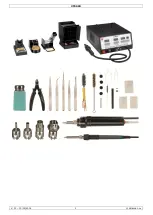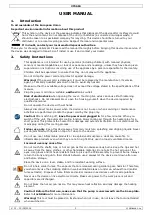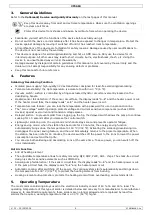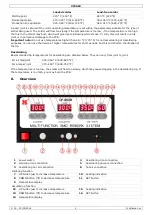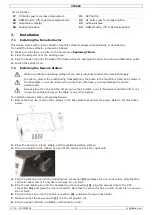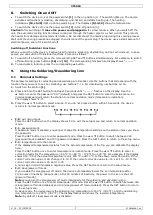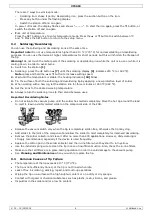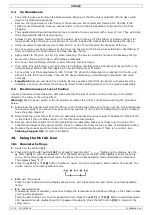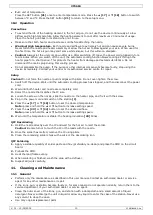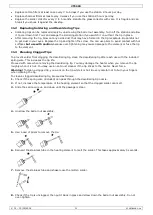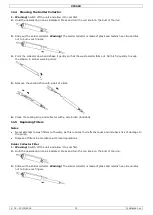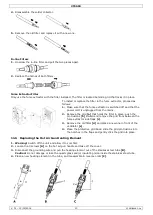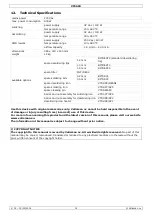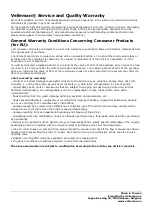
VTSSD4
V. 01
–
15/05/2014
4
©Velleman nv
3.
General Guidelines
Refer to the
Velleman® Service and Quality Warranty
on the last pages of this manual.
Keep this device away from dust and extreme temperatures. Make sure the ventilation openings
are clear at all times.
Protect this device from shocks and abuse. Avoid brute force when operating the device.
Familiarise yourself with the functions of the device before actually using it.
Do not switch the device on immediately after it has been exposed to changes in temperature. Protect the
device against damage by leaving it switched off until it has reached room temperature.
All modifications of the device are forbidden for safety reasons. Damage caused by user modifications to
the device is not covered by the warranty.
This device is designed for soldering/desoldering and hot air SMD rework. Only use the device for its
intended purpose. All other uses may lead to short circuits, burns, electroshocks, crash, etc. Using the
device in an unauthorized way will void the warranty.
Damage caused by disregard of certain guidelines in this manual is not covered by the warranty and the
dealer will not accept responsibility for any ensuing defects or problems.
Keep this manual for future reference.
4.
Features
Soldering/Desoldering Function
Isolated power supply: high-quality 32 Vac transformer designed for lead-free soldering/desoldering.
Temperature stability: the tip temperature is accurate to within ± 3 °C (6 °F).
Vacuum switch: suction is controlled by a finger-actuated thyristor circuit conveniently located on the
desoldering handle.
Heater/sensor fail detection: if the sensor circuit fails, the display reads "S--E" and the heater power is cut.
If the heater circuit fails, the display reads "H--E" and the heater power is cut.
Temperature lock feature: you can lock the temperature with a password for use in a production line.
The “zero voltage” switching design pr
otects voltage and current sensitive components (such as CMOS
devices) against overcurrent and transient voltage spikes.
Delayed suction: to prevent solder from clogging up the tip, the delayed switch allows the pump to continue
sucking for 1.5 seconds after you release the control switch.
Lightweight soldering iron: the ergonomic mini handle stays cool and prevents operator fatigue.
Energy saving mode: when the station has been idle for 20 minutes, the energy saving function
automatically brings down the temperature to 150 °C (302 °F). Activating the soldering/desoldering iron
disengages the power saving feature, and the unit immediately returns to the preset temperature. When
the station has been idle for 40 minutes, the device switches off the power to the irons to lower the power
consumption and extend the tip life.
You can use both soldering and desoldering irons at the same time. To save power, you can switch off the
irons individually.
Hot Air Function
600 W heating element
The adjustable temperature allows for safely removing QFP, SOP
, PLCC, SOJ… chips
. The static-free circuit
design is safe for sensitive elements such as CMOS ICs.
Sensor/pump fail detection: if the sensor circuit fails, the display reads "S--E" and the heater power is cut.
If the pump circuit fails, the display reads "P--E" and the heater power is cut.
Automatic cooling: after switching off the power, the cooling system starts automatically and brings down
the temperature to 100 °C (212 °F) to protect the heating element from burning.
Heating element auto-protection: protects the heating element from overheating, and extends its life.
5.
Operating Temperature
The most common soldering alloys used in the electronics industry consist of 60 % tin and 40 % lead. The
operating temperature of this type of solder is detailed below and can vary from manufacturer to manufacturer.
However, to meet RoHS requirements, these solders are no longer allowed and are replaced by lead-free
solders that require a working temperature that is ± 30 °C (54 °F) higher.


